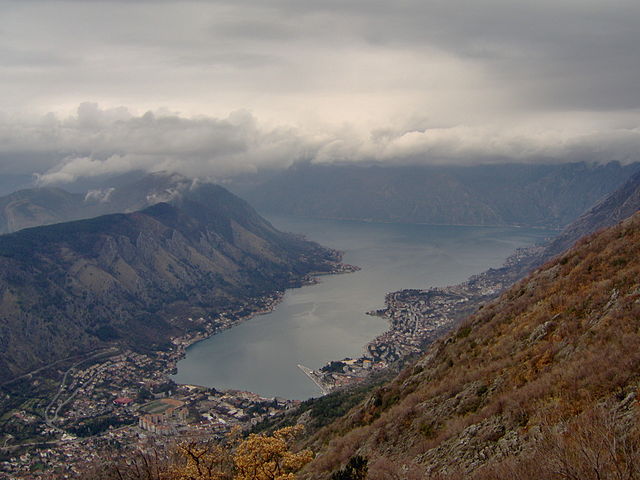Loading AI tools
From Wikipedia, the free encyclopedia
Montenegro (Montenegrin: Црна Гора, romanized: Crna Gora; lit. "Black Mountain") is a small, mountainous country in Southeast Europe. It borders Croatia, Bosnia and Herzegovina, Serbia, Kosovo, Albania and the Adriatic Sea. While being a small country at 13,812 km2 (5,333 sq mi), it is very diverse regarding the terrain configuration.[1] Montenegro has 50 peaks of over 2,000 m (6,600 ft) in altitude.



Terrain in Montenegro ranges from high mountains in the northern part of the country, through karst segment in central and western part, to almost 300 km (190 mi) of a narrow coastal plain. The coastal plain disappears completely in the north, where Mount Lovćen and other mountain ranges plunge abruptly into the inlet of the Gulf of Kotor. The coastal region is noted for active seismicity.[2]
Montenegro's section of the karst lies generally at elevations of 1,000 m (3,281 ft) above sea level-although some areas rise to 1,800 m (5,906 ft). The lowest segment is in the valley of the Zeta River, which flows at an elevation ranging from 650 m (2,133 ft) to 45 m (148 ft). The river occupies the centre of Nikšić field, a flat-floored, elongated depression typical of karstic regions. The underlying rock is predominantly limestone, which dissolves to form sinkholes and caves. The longest cave in Montenegro is Vražji firovi - 10,5 km long cave north-east from Berane, and the deepest sinkhole is Željezna jama -1027 m on mount Maganik.[3]
The Zeta River Valley, or Bjelopavlići plain, merges in the southeast with the second significant flat lowland in Montenegro, the Zeta plain. Zeta plain stretches north of the Lake Scutari at elevation of 40 m (131 ft). The two plains are today the most densely populated areas of Montenegro, housing the two biggest Montenegrin cities, Podgorica and Nikšić.[4]
The high mountains of Montenegro include some of the most rugged terrain in Europe. They average more than 2,000 m (6,562 ft) in elevation. Among notable peaks is Bobotov Kuk in the Durmitor mountain, which reaches 2,523 m (8,278 ft). The Montenegrin mountains were the most ice-eroded section of the Balkan Peninsula during the last glacial period.[2]

The coast of Montenegro is 294 km (183 mi) long. Unlike its northern neighbour Croatia, Montenegro has no large inhabited islands along the coast. A notable feature of the Montenegrin coast is Bay of Kotor, a fjord-like gulf, which is in fact a submerged river canyon. The Bay of Kotor is surrounded by mountains up to 1,000 m (3,281 ft) high, which plunge almost vertically into the sea.[2]
To the south of the Bay of Kotor, there is a narrow coastal plain, no more than 4 km wide, which is guarded from the north by high mountains. The plain provided space for numerous small coastal settlements.[5]

Montenegro's surface runoff in the north is carried away by the Lim and Tara river systems, which enter the Danube via the Drina River of Bosnia and Herzegovina. In southern Montenegro, streams flow toward the Adriatic Sea. Much of the drainage of the karstic region is not on the surface but travels in underground channels.[6]
The largest lake in Montenegro and the Balkans is Lake Scutari. Known in Montenegro as Skadarsko Jezero, it lies near the coast and extends across the international border into northern Albania. It is 50 km (31 mi) long and 16 km (9.9 mi) wide, with a total surface area of 370 km2 (142.9 sq mi). Some 60 percent lies within Montenegrin territory. The water body occupies a karstic polje depression that has a floor lying below sea level.[6]
Montenegro's mountainous regions are noted for their numerous lakes.[6]
Geographic coordinates: 42°30′N 19°18′E[7]
Area - comparative: similar in size to The Bahamas[7]
Area
Total: 13,812 km2 (5,332 sq mi)[7]
Land: 13,452 km2 (5,193 sq mi)[7]
Water: 360 km2 (138 sq mi)[7]
Population: 620,029 (2011 census);[8] 653,474 (2013 estimate )
Length of the coast (coastline): 293.5 km (182 mi)[7]
Length of the international borders: 625 km (388 mi) (all)[7]
Land under cultivation: 517,153 ha
Land use:
Irrigated land: 24.12 km2
Maritime claims: 12 nm[7]
| Climate data for Montenegro | |||||||||||||
|---|---|---|---|---|---|---|---|---|---|---|---|---|---|
| Month | Jan | Feb | Mar | Apr | May | Jun | Jul | Aug | Sep | Oct | Nov | Dec | Year |
| Record high °C (°F) | 21.2 (70.2) |
27.2 (81.0) |
27.4 (81.3) |
33.8 (92.8) |
35.4 (95.7) |
40.5 (104.9) |
43.3 (109.9) |
44.8 (112.6) |
39.6 (103.3) |
32.6 (90.7) |
28.4 (83.1) |
22.6 (72.7) |
44.8 (112.6) |
| Record low °C (°F) | −29.8 (−21.6) |
−26.3 (−15.3) |
−25.3 (−13.5) |
−14.6 (5.7) |
−10.0 (14.0) |
−4.0 (24.8) |
0.4 (32.7) |
−0.2 (31.6) |
−6.4 (20.5) |
−11.3 (11.7) |
−23.4 (−10.1) |
−27.0 (−16.6) |
−29.8 (−21.6) |
| Source: Hydrological and Meteorological Service of Montenegro[11] | |||||||||||||
Seamless Wikipedia browsing. On steroids.
Every time you click a link to Wikipedia, Wiktionary or Wikiquote in your browser's search results, it will show the modern Wikiwand interface.
Wikiwand extension is a five stars, simple, with minimum permission required to keep your browsing private, safe and transparent.